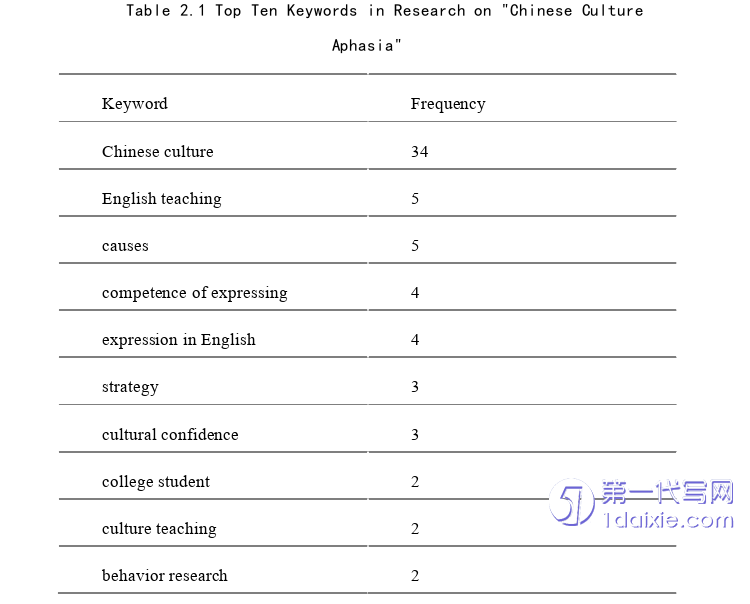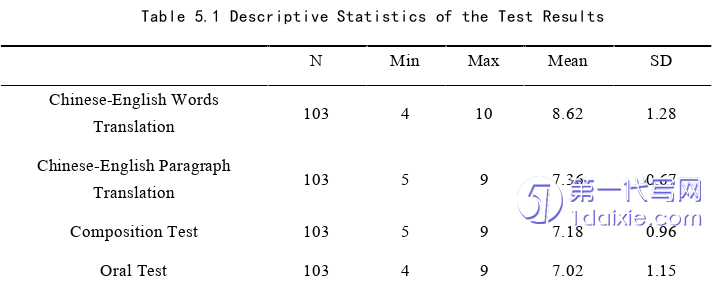本文是一篇英语毕业论文,本研究运用了问卷调查、测试和访谈三种研究方法,对非英语专业大学生的中国文化英语表达能力及相关教学进行了全面评估与研究。
Chapter One Introduction
1.1 Research Background
With the development of technology and society, countries are becoming increasingly interconnected, and intercultural communication has become an indispensable theme for China's development. China aspires to collaborate with nations across the globe in fostering a community with a shared future for mankind, thereby collectively striving to achieve common prosperity.
Under this trend of internationalization, it is of paramount importance to strengthen the outbound communication of Chinese culture and spread China’s voice to the world. When presiding over the 30th collective study session of the 19th Political Bureau of the Central Committee, President Xi emphasized that telling China's stories well, spreading China's voice effectively, and presenting a true, multi-dimensional, and panoramic view of China are important tasks in the international communication between China and other countries. Only by spreading its excellent culture overseas can China improve its cultural soft power, enhance the centripetal force of the Chinese nation domestically, and improve its national image and prestige internationally. In 2018, President Xi pointed out further in The National Publicity and Ideological Work Conference:
It is necessary to continuously enhance the influence of Chinese culture... China should take the initiative in telling China's stories well about the CPC's governance, the Chinese people's struggle to realize their dreams, and China's insistence on peaceful development and win-win cooperation, so that the world can better understand China.

1.2 Research Purpose
To cultivate talents who can spread Chinese culture proficiently and tell Chinese story effectively, this thesis aims to explore how to cultivate the CECCE among non-English majors in College English teaching, especially in the course Expressing Chinese Culture in English. To be more specific, the following are the research purposes to be achieved in this thesis:
One of the objectives of this study is to assess the CECCE of non-English majors in the course Expressing Chinese Culture in English. This assessment aims to provide insights into students' mastery of Chinese culture and their ability to express Chinese culture effectively in English during the course of study through both quantitative and qualitative analysis. Through this assessment, the study aims to identify the major challenges and difficulties students encounter in expressing Chinese culture, as well as their performance in terms of linguistic accuracy, fluency, and cultural adaptability, thus providing a basis for subsequent improvement in culture teaching.
The second objective of the study is to investigate the views and perceptions of teachers and students participating in the course Expressing Chinese Culture in English to develop students' CECCE. Through questionnaires and interviews, the study will collect teachers' and students' views on the course content, teaching methods, learning resources and assessment mechanisms. The results will help reveal the effectiveness of the course in achieving its pedagogical goals, as well as specific suggestions from teachers and students for course improvement. These insights will provide valuable feedback for course designers to optimize course implementation and enhance teaching effectiveness.
Chapter Two Literature Review
2.1 Culture Teaching in Foreign Language Education
2.1.1 Definition of Culture Teaching in FLE
Language is a reflection of culture, a vehicle for it, and a means of communication. Therefore, while teaching language, it is essential to introduce the cultural background and social customs of the country where the language is spoken at the appropriate time (Zhang, 1997). The ultimate goal of foreign language teaching is to cultivate the ability to use the language effectively; communicative competence is inseparable from understanding the culture of the country where the language is spoken. Learning a language inevitably involves learning the culture that language represents, and it is very necessary to incorporate cultural teaching in foreign language education at present (Gao, 1994).
Culture teaching refers to the teaching of relevant cultural background knowledge to learners in the process of FLT (Fries, 1945; Stern, 1983). In Guidelines on College English Teaching (2020 Edition), it is pointed out that one of the important tasks of the College English program is to carry out intercultural education. English is the carrier of culture, and the English course is the main battlefield of culture teaching and learning.
2.2 Chinese Culture Aphasia in FLE
2.2.1 Definition of Chinese Culture Aphasia in FLE
Since the 1990s, the research on culture teaching in FLT has begun to shift from a unilateral focus on the learning of the target language culture to a focus on bilateral interaction between the target language culture and the culture of the mother tongue (Gao, 1994). Researchers have realized that culture teaching in foreign language education should not be limited to the input of Western culture, but should also include the input of excellent Chinese culture (Zhang& Zhu, 2002; Zhou& Xue, 2019). Only by ensuring the two-way input of culture in College English teaching, the integration of Chinese and Western cultures in College English teaching can be effectively realized (Ma, 2019).
However, students lack the understanding of Chinese culture since current English teaching favors Western culture and barely touches on Chinese culture in the process of FLT (Zhang, 2003), which leads to the “Chinese culture aphasia”. The term “aphasia” originated from the medical field and has many different definitions, among which the commonly used clinical definition is the one proposed by Benson (1979), which defines aphasia as the loss or impairment of language function caused by the impairment of brain function.
Chapter Three Theoretical Foundation .............................. 20
3.1 Development of POA ................................................... 20
3.2 Theoretical Framework of POA ........................................ 23
Chapter Four Research Design .................................... 30
4.1 Research Questions ............................... 30
4.2 Research Subjects ................................. 30
Chapter Five Findings and Discussion ........................... 50
5.1 Current Situation of CECCE ........................................... 50
5.1.1 Results and Discussion of the Test ................................ 50
5.1.2 Students and Teachers' Perceptions on CECCE .................................... 55
Chapter Five Findings and Discussion
5.1 Current Situation of CECCE
The current study primarily employed a testing method to assess the status quo of CECCE, complemented by questionnaires and interviews to gather insights from both students and teachers.
5.1.1 Results and Discussion of the Test
5.1.1.1 The Overall Results of the Test
This test consisted of four parts: Chinese-English phrase translation, Chinese-English paragraph translation, composition and oral test and 130 students from three classes were invited to take the test. Among them, 27 test results were invalid because the students didn’t take it. The test results are shown in Table 5.1.

Chapter Six Conclusion
6.1 Major Findings
This study analyzed the CECCE of non-English major college students and its cultivation through questionnaires, tests and interviews with POA functioning as the research framework. Major findings of this study are presented as follows:
Firstly, although some students expressed a lack of confidence in their CECCE and teachers specified some deficiencies in students’ CECCE, the majority of the students demonstrated strong writing and translation skills in terms of CECCE. However, there is significant room for improvement in their oral proficiency. Overall, the course has effectively enhanced students' CECCE, indicating a successful implementation and students’ proficiency in expressing Chinese culture in English.
Secondly, teachers and students hold a positive view of the role of the course in cultivating learners’ CECCE and the implementation of the course Expressing Chinese Culture in English. Students show a strong interest in Chinese culture and recognize the importance of expressing it in English. Teachers also affirm the course's effectiveness in bridging the gap between language learning and development of CECCE. They maintained that the course not only boosts students' cultural confidence but also aligns with national policies aimed at promoting traditional culture dissemination and fostering international talent with high CECCE.
reference(omitted)
